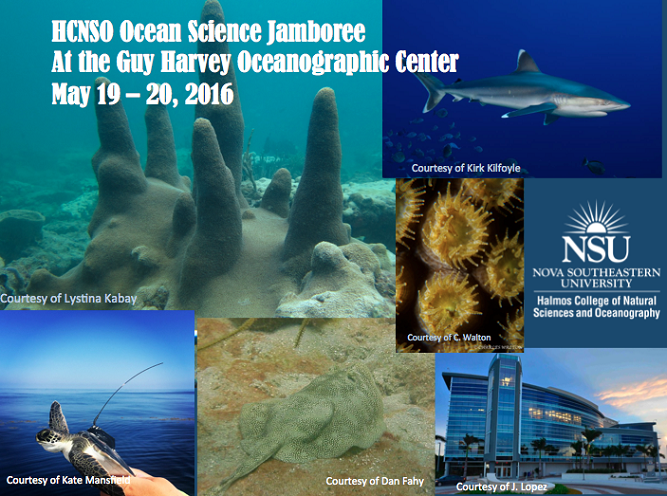Location
Guy Harvey Oceanographic Center Facility
Start
5-20-2016 11:15 AM
End
5-20-2016 11:30 AM
Abstract
Bear Seamount (39° 55’ N; 67° 30’ W) is the westernmost peak of extinct undersea volcanoes in the New England Seamount Chain (Moore et al., 2003). It is located on the continental slope off Georges Bank, and is governed by unique environmental factors and currents that may be unlike those of the other seamounts (Moore et al., 2003). Previous cruises to this seamount have been successful in capturing abundant fishes, cephalopods and invertebrates (Moore et al., 2003; Moore et al., 2004; Moore et al., 2008), but only the distribution patterns of the fishes and cephalopods have been examined, leaving a lack of information on the deep-sea crustaceans. The diversity, catch per unit effort (CPUE) and local biogeography of trawl-vulnerable micronekton in the vicinity of Bear Seamount were investigated, with primary focus on baseline data collection. Sixty-six species of pelagic crustacea (Decapoda, Lophagastrida, Euphausiacea) were collected at 35 oblique trawl stations in the spring of 2003 and 2004 and fall of 2014 with the International Young Gadoid Pelagic Trawl (IYGPT) and a Polytron Midwater Rope Trawl (PMRT). Depths sampled ranged from the surface to 1700m, with most trawls sampling primarily below 1000 m. When comparing relative biogeography of the nekton in the fall samples, the summit of the seamount was the most diverse and the west side of the seamount had the greatest species richness. In the spring samples, the west side of the seamount was the most diverse and species rich. These data indicate a seasonal shift in local biogeography. Overall CPUE was dominated by cold temperate species, typical of mid- to – higher – latitudes in the North Atlantic. Eusergestes arcticus and Meganyctiphanes norvegica were particularly dominant in both the spring and fall samples. At least two species were new records for Northwest Atlantic waters and may have traveled by means of currents and or from nearby seamounts.
Included in
Abundance and Diversity of Deep-Sea Crustaceans of Bear Seamount, New England Seamount Chain
Guy Harvey Oceanographic Center Facility
Bear Seamount (39° 55’ N; 67° 30’ W) is the westernmost peak of extinct undersea volcanoes in the New England Seamount Chain (Moore et al., 2003). It is located on the continental slope off Georges Bank, and is governed by unique environmental factors and currents that may be unlike those of the other seamounts (Moore et al., 2003). Previous cruises to this seamount have been successful in capturing abundant fishes, cephalopods and invertebrates (Moore et al., 2003; Moore et al., 2004; Moore et al., 2008), but only the distribution patterns of the fishes and cephalopods have been examined, leaving a lack of information on the deep-sea crustaceans. The diversity, catch per unit effort (CPUE) and local biogeography of trawl-vulnerable micronekton in the vicinity of Bear Seamount were investigated, with primary focus on baseline data collection. Sixty-six species of pelagic crustacea (Decapoda, Lophagastrida, Euphausiacea) were collected at 35 oblique trawl stations in the spring of 2003 and 2004 and fall of 2014 with the International Young Gadoid Pelagic Trawl (IYGPT) and a Polytron Midwater Rope Trawl (PMRT). Depths sampled ranged from the surface to 1700m, with most trawls sampling primarily below 1000 m. When comparing relative biogeography of the nekton in the fall samples, the summit of the seamount was the most diverse and the west side of the seamount had the greatest species richness. In the spring samples, the west side of the seamount was the most diverse and species rich. These data indicate a seasonal shift in local biogeography. Overall CPUE was dominated by cold temperate species, typical of mid- to – higher – latitudes in the North Atlantic. Eusergestes arcticus and Meganyctiphanes norvegica were particularly dominant in both the spring and fall samples. At least two species were new records for Northwest Atlantic waters and may have traveled by means of currents and or from nearby seamounts.


